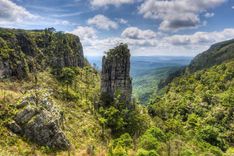13. Wildebeest Kuil Rock Art Centre
Just outside Kimberley, the Wildebeest Kuil Rock Art Centre preserves more than 400 engravings made by the San people, some of which are over 2,000 years old. Instead of being painted, these images were chipped into ironstone boulders, which is why they’ve lasted so long.
Many show animals like rhino, elephant, and eland, while others are abstract shapes linked to spiritual traditions. Later, Khoi herders added their own markings, so the site reflects different layers of history.
The visitor center explains the cultural meaning of the engravings and how they were created. A raised boardwalk leads you around the site without damaging it, and the hilltop setting gives wide views over the Karoo.
14. Tankwa Karoo National Park
Tankwa Karoo is where two very different ecosystems meet: winter-rainfall Fynbos and summer-rainfall Karoo. The Tankwa River is usually dry, flowing only once in a decade, but even so the area supports a surprising variety of life. After a rare rain, the ground quickly fills with flowers, insects, and breeding birds.
Cape mountain zebras have been reintroduced here, and the park is also important for climate research. Fossil beds point to a time when this land held large lakes, which is hard to imagine now.
Driving the Gannaga Pass gives you sweeping views over the Roggeveld Escarpment. At night, the skies are incredibly clear, and the park borders the SKA radio telescope site, making it a major place for astronomy. Seasonal wetlands attract rare birds like Ludwig’s bustard. Temperatures are extreme, dropping to around 23°F (-5°C) in winter and climbing up to 113°F (45°C) in summer.


















